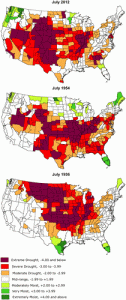Every time there is a drought, I am asked how the latest drought compares to the historical droughts of the 1930s and 1950s, which were terrible droughts that covered a substantial part of the US. Now there is a new popular paper which discusses the comparison between the early 21st century drought from 1998-2014 (which does not include the Southeast’s terrible drought of 2016-2017 but does cover our earlier droughts of 1998-2002, 2007-2009, and 2011-2013) and the two earlier wide-scale drought periods by Dr. Richard Heim of the National Centers for Environmental Information. He is the foremost expert on historical drought in the US and has provided us with a look at the differences between those three drought periods in a new research article. He has also provided a more readable version for non-scientists. The links to the two articles are below.
This excerpt from the abstract describes the differences: “The 1998–2014 drought episode is compared to the two other major drought episodes of the twentieth century in terms of duration, areal extent, intensity, and spatial pattern using operational datasets produced by the National Oceanic and Atmospheric Administration/National Centers for Environmental Information. It is characterized by more short-term dryness, more concurrent (regional) wetness, and warmer temperatures than the other two drought episodes.”
WeatherNation: A historical perspective on droughts
Bulletin of the American Meteorological Society: A Comparison of the Early Twenty-First Century Drought in the United States to the 1930s and 1950s Drought Episodes
